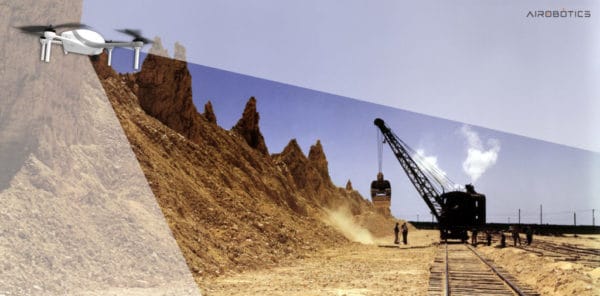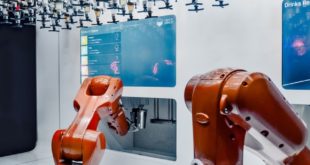Automation might be the buzzword in many industries, but pardon the mining industry if this craze doesn’t register as particularly novel. After all, while organizations around the world were going wild over these new-fangled computers in the 1980s, the mining industry was attempting to automate surface mining equipment weighing in the hundreds of tons.
Those three-plus decades of dedication to automation are paying off now in the form of significant innovations that are resulting in increased productivity and decreased costs, and those innovations are operating both on the ground and in the air.
Automated hauling
Automated trucks for the mining industry went into formal testing in 2011, and a rigorous six years later, British mining company Rio Tinto has a total of 73 self-driving, entirely unmanned trucks hauling iron ore at four mine sites in Australia in one of the biggest showcases of automation in the mining industry.
Each truck weighs about 416 tons, and that’s before loading. The trucks are programmed to drive to a job site, be loaded, and then drive to another pre-selected location – no human driver or any type of operator on board. In fact, the people in charge of these automated vehicles are over 750 miles away.
Automated haul trucks cut costs by eliminating personnel-related costs and make operations more productive by running 24 hours a day. With preprogrammed routes, automated trucks are also unsusceptible to the kind of human error that can cause accidents and other costly damages. Thus far, Rio Tinto has found its automated fleet of haul trucks to be 15% cheaper than a fleet requiring human drivers. Removing human operators from the hauling process also reduces or eliminates the chances of injury or loss of life due to a haul truck incident – not a small consideration.
While automated trucks are set to benefit mining organizations in increased productivity and decreased costs and safety risk when it comes to the hauling process, there is another automated innovation revolutionizing the mining industry and doing so with a much wider scope.
Aiming higher
For significant cost savings, the surface mining industry is looking to the air. Automated industrial drones can affect cost savings and improved productivity in nearly every aspect of surface mining operations including drilling and blasting, hauling, surveying and evaluating stockpiles, and incident response.
In order to impact so many mining processes while actually cutting costs, an industrial drone requires two main things. The first is true end-to-end automation, allowing a drone to operate with either little or no human intervention and no human errors. This means no human pilot driving up costs and slowing down response time, no humans needed for basic maintenance like battery swapping, and no humans needed for changing sensors and payloads.
Those interchangeable sensors and payloads are the second requirement for a truly game-changing innovation. When a drone can be automatically outfitted with any number of sensors it becomes an industrial multi tool, one with a wide range of applications and cost-saving capabilities.
Drone duties
With their immense data collecting and processing capabilities as well as their photo grammetry and imaging capabilities, automated drones play a role in almost every part of ore’s life cycle as it goes from deep in the ground to the top of a stockpile at a surface mine. This begins with the drilling and blasting process.
Automated drones for mining help ensure the quality of a blast by comparing the drill-hole alignment in a blast plan with a geo referenced image of actual drill-hole positions, allowing for crucial adjustments that will help produce the desired fragmentation size, which optimizes loading and crushing and minimizes wear and tear on equipment. Leading automated drones can also quickly provide both pre- and post-blast digital elevation models, saving on the many hours of manpower that can go into traditional surveying. With live stream video a drone can provide a fast but comprehensive visual assessment of the blast site prior to the blast, ensuring all personnel and equipment are at a safe distance, and can provide almost-immediate fragmentation analysis to benchmark blast success and inform downstream comminution processes.
The cost savings afforded by automated drones in the hauling process largely relate to the benefits reaped by regular and detailed inspections of haul roads. With even a 1% rolling increase leading to slower cycle times and higher fuel costs, the data provided by an automated drone is essential for maintaining optimal hauling conditions, and that data is provided without having to stop operations the way that traditional inspections occur and with a higher degree of precision than could ever be accomplished by human surveyors. Furthermore, this is normally documented with a pen and paper checklist which renders no means of archiving the data and then reusing it to produce insights about the roads and inspection process itself. Automated drones are also capable of providing a real-time assessment of damage that requires an immediate fix, getting information to the engineers faster and minimizing costly traffic delays.
Surveying and stockpile evaluation also greatly benefit from the time savings made possible by automated drones, completing in hours what would take traditional surveyors days. Further, as pointed out by leading automated drone manufacturer Airobotics, automated drones provide a higher level of accuracy in stockpile evaluation, as noted in a case study with Israel Chemicals Ltd.
Lastly, a drone designed with true automation in mind simply cannot be beat when it comes to emergency response. Whether heading to a blast site, a haul road incident or any other type of emerging situation, a truly automated drone is always ready to fly and can immediately transmit essential information that could help save critical infrastructure, equipment, and even human lives. Automated drones can also eliminate the costs associated with surveillance equipment like CCTV cameras by flying regular security missions and providing incident response.
Automation on the horizon
In the not-so-distant future the mining industry will likely see major automation innovations in drilling, excavating, loading as well as further automation in the hauling process. While the industry is undoubtedly keeping its eye on what’s coming next, as it has been for decades when it comes to automation, decision-makers have to be pleased with what they’ve already seen from their current automated solutions while striving to continue digitizing mines in groundbreaking ways.
 Gearfuse Technology, Science, Culture & More
Gearfuse Technology, Science, Culture & More



